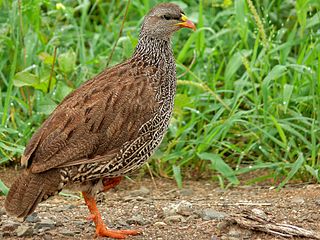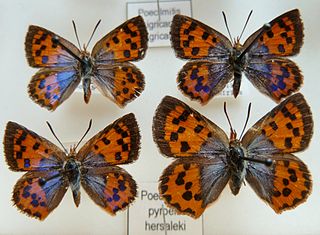
Myrmicinae is a subfamily of ants, with about 140 extant genera; their distribution is cosmopolitan. The pupae lack cocoons. Some species retain a functional sting. The petioles of Myrmicinae consist of two nodes. The nests are permanent and in soil, rotting wood, under stones, or in trees.

Dorylus, also known as driver ants, safari ants, or siafu, is a large genus of army ants found primarily in central and east Africa, although the range also extends to southern Africa and tropical Asia. The term siafu is a loanword from Swahili, and is one of numerous similar words from regional Bantu languages used by indigenous peoples to describe various species of these ants. Unlike the New World members of the former subfamily Ecitoninae, members of this genus form temporary subterranean bivouacs in underground cavities which they excavate and inhabit - either for a few days or up to three months. Also unlike some New World army ants, driver ants are not specialized predators of other species of ant, instead being more generalistic with a diet consisting of a diversity of arthropods. Colonies are enormous compared to other army ants and can contain over 20 million individuals. As with their American counterparts, workers exhibit caste polymorphism with the soldiers having particularly large heads that power their scissor-like mandibles. They are capable of stinging, but very rarely do so, relying instead on their powerful shearing jaws. Driver ant queens are the largest living ants known, with the largest measuring between 40 - 63 millimeters in total body length depending on their physiological condition.

The red forest duiker, Natal duiker, or Natal red duiker is a small antelope found in central to southern Africa. It is one of 22 extant species form the subfamily Cephalophinae. While the red forest duiker is very similar to the common duiker, it is smaller in size and has a distinguishing reddish coloring. Additionally, the red forest duiker favors a denser bush habitat than the common duiker. The Natal red duiker is more diurnal and less secretive than most forest duikers, so therefore it is easier for them to be observed. In 1999, red forest duikers had an estimated wild population of 42,000 individuals.

The Natal multimammate mouse is a species of rodent in the family Muridae. It is also known as the Natal multimammate rat, the common African rat, or the African soft-furred mouse. The Natal multimammate rat is the natural host of the Lassa fever virus.

The Natal spurfowl or Natal francolin is a species of bird in the family Phasianidae. It is found in Botswana, Eswatini, Mozambique, South Africa, Zambia, and Zimbabwe.

The African yellow warbler, also known as Natal yellow warbler, dark-capped yellow warbler or yellow flycatcher-warbler, is a species of Acrocephalidae warblers; formerly, these were placed in the paraphyletic "Old World warblers".

The red-capped robin-chat or Natal robin is a species of bird in the family Muscicapidae.

The Natal hinge-back tortoise, also known as Natal hinge-backed tortoise or Natal hinged tortoise, is a species of tortoise in the family Testudinidae which is restricted to eastern southern Africa to a relatively small area around the borders of Mozambique, South Africa, and Eswatini.

Chrysoritis oreas, the Drakensberg copper or Drakensberg daisy copper, is a species of butterfly in the family Lycaenidae. It is endemic to South Africa, where it is found in montane grassland in the eastern KwaZulu-Natal Drakensberg foothills.
(Orachrysops ariadne), the Karkloof blue, is a species of butterfly in the family Lycaenidae.

Vittina natalensis, commonly known as spotted nerite or zebra nerite, is a species of small freshwater snail with an operculum, an aquatic gastropod mollusk in the family Neritidae, the nerites. It returns to brackish waters to reproduce. This is a popular aquarium snail, sold because it looks attractive and eats algae in freshwater tanks, but can only reproduce in saltwater or brackish water conditions.

Myrmicaria is an ant genus within the subfamily Myrmicinae.

Solenopsidini is a tribe of myrmicine ants with about 20 genera.

Chrysoritis pyroeis, the sand-dune opal, is a butterfly of the family Lycaenidae. It is found in South Africa.
Chrysoritis natalensis, the Natal opal, is a butterfly of the family Lycaenidae. It is found in South Africa, where it is found from the Eastern Cape, along the coast of KwaZulu-Natal and inland to Zululand and the midlands.
Allotinus apries is a butterfly in the family Lycaenidae. It was described by Hans Fruhstorfer in 1913. It is found in Asia.

BBC Earth is a documentary subscription television channel featuring premium factual programming. The channel is wholly owned and operated by BBC Studios. Originally set to roll out internationally in 2014, it was later announced that it would launch in 2015, starting in Poland.
Diacamma ceylonense, also known as Sri Lanka queenless ant, is a species of ant of the subfamily Ponerinae. It is a widespread species.
Opisthopatus natalensis is a species of velvet worm in the Peripatopsidae family. This species has 16 pairs of legs. The type locality is in South Africa. The validity of this species is uncertain: Although some authorities have deemed O. natalensis to be a subspecies of O. cinctipes, a similar species also found in South Africa, and others regard O. natalensis as invalid even as a subspecies, still other authorities recognize O. natalensis as a separate species, citing the significant distance between the type localities of these two species.

The Southern African rock python is a large python species native to Southern Africa inhabiting savanna and woodland. It was first described by Andrew Smith in 1833. Growing a length of more than 5 m (16 ft), this is one of the largest snakes in the world.

















